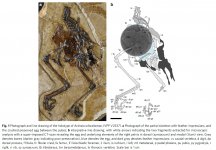Fred Ruhe
Well-known member

Alida M. Bailleul, Jingmai O’Connor, Shukang Zhang, Zhiheng Li, Qiang Wang, Matthew C. Lamanna, Xufeng Zhu & Zhonghe Zhou, 2019
An Early Cretaceous enantiornithine (Aves) preserving an unlaid egg and probable medullary bone
Nature Communications. 10: Article number 1275. doi:10.1038/s41467-019-09259-x
Free pdf: https://www.nature.com/articles/s41467-019-09259-x.pdf
Abstract:
Understanding non-crown dinosaur reproduction is hindered by a paucity of directly associated adults with reproductive traces. Here we describe a new enantiornithine, Avimaia schweitzerae gen. et sp. nov., from the Lower Cretaceous Xiagou Formation with an unlaid egg two-dimensionally preserved within the abdominothoracic cavity. Ground-sections reveal abnormal eggshell proportions, and multiple eggshell layers best interpreted as a multilayered egg resulting from prolonged oviductal retention. Fragments of the shell membrane and cuticle are both preserved. SEM reveals that the cuticle consists of nanostructures resembling those found in neornithine eggs adapted for infection-prone environments, which are hypothesized to represent the ancestral avian condition. The femur preserves small amounts of probable medullary bone, a tissue found today only in reproductively active female birds. To our knowledge, no other occurrence of Mesozoic medullary bone is associated with indications of reproductive activity, such as a preserved egg, making our identification unique, and strongly supported.
Enjoy,
Fred
An Early Cretaceous enantiornithine (Aves) preserving an unlaid egg and probable medullary bone
Nature Communications. 10: Article number 1275. doi:10.1038/s41467-019-09259-x
Free pdf: https://www.nature.com/articles/s41467-019-09259-x.pdf
Abstract:
Understanding non-crown dinosaur reproduction is hindered by a paucity of directly associated adults with reproductive traces. Here we describe a new enantiornithine, Avimaia schweitzerae gen. et sp. nov., from the Lower Cretaceous Xiagou Formation with an unlaid egg two-dimensionally preserved within the abdominothoracic cavity. Ground-sections reveal abnormal eggshell proportions, and multiple eggshell layers best interpreted as a multilayered egg resulting from prolonged oviductal retention. Fragments of the shell membrane and cuticle are both preserved. SEM reveals that the cuticle consists of nanostructures resembling those found in neornithine eggs adapted for infection-prone environments, which are hypothesized to represent the ancestral avian condition. The femur preserves small amounts of probable medullary bone, a tissue found today only in reproductively active female birds. To our knowledge, no other occurrence of Mesozoic medullary bone is associated with indications of reproductive activity, such as a preserved egg, making our identification unique, and strongly supported.
Enjoy,
Fred




